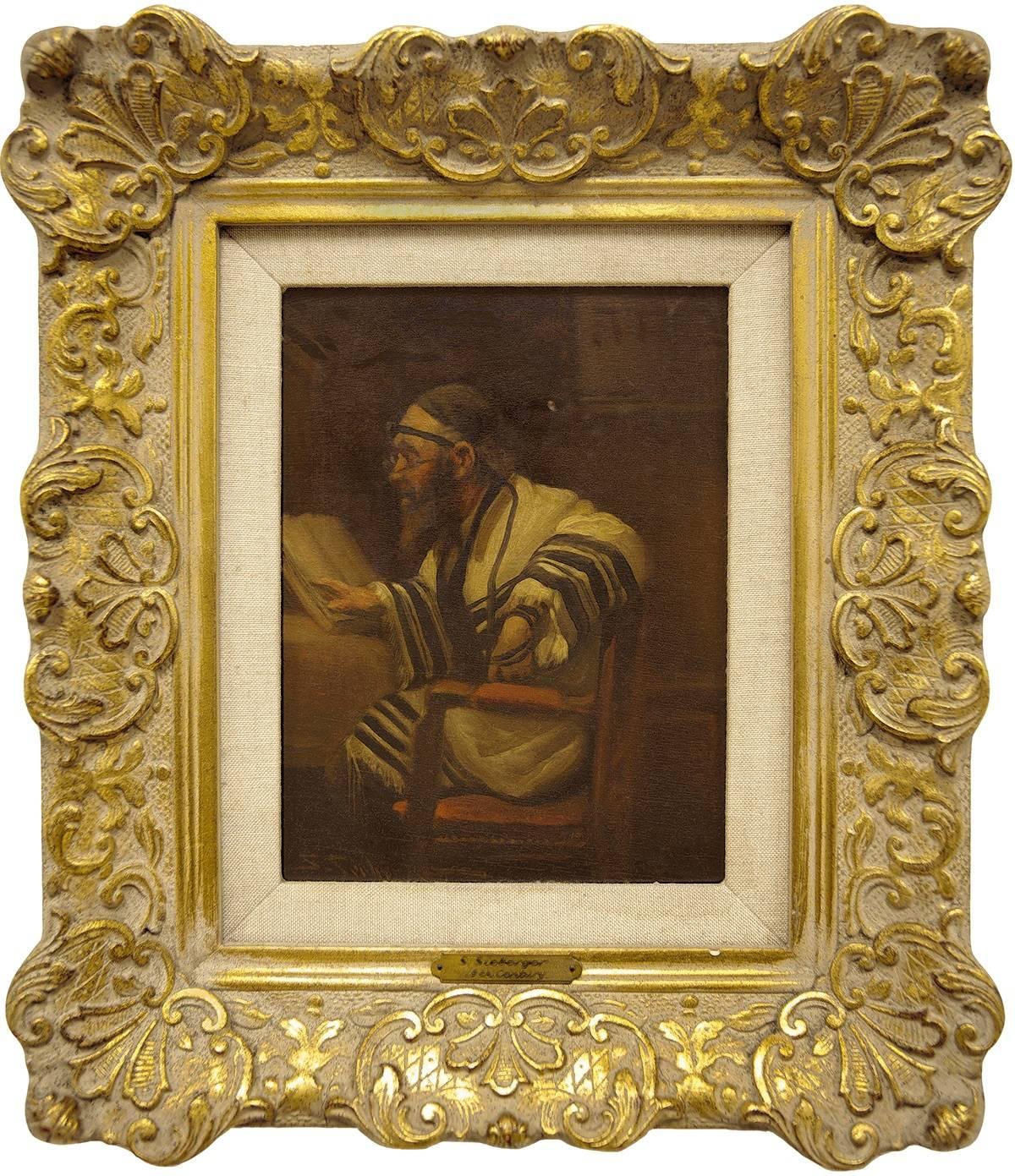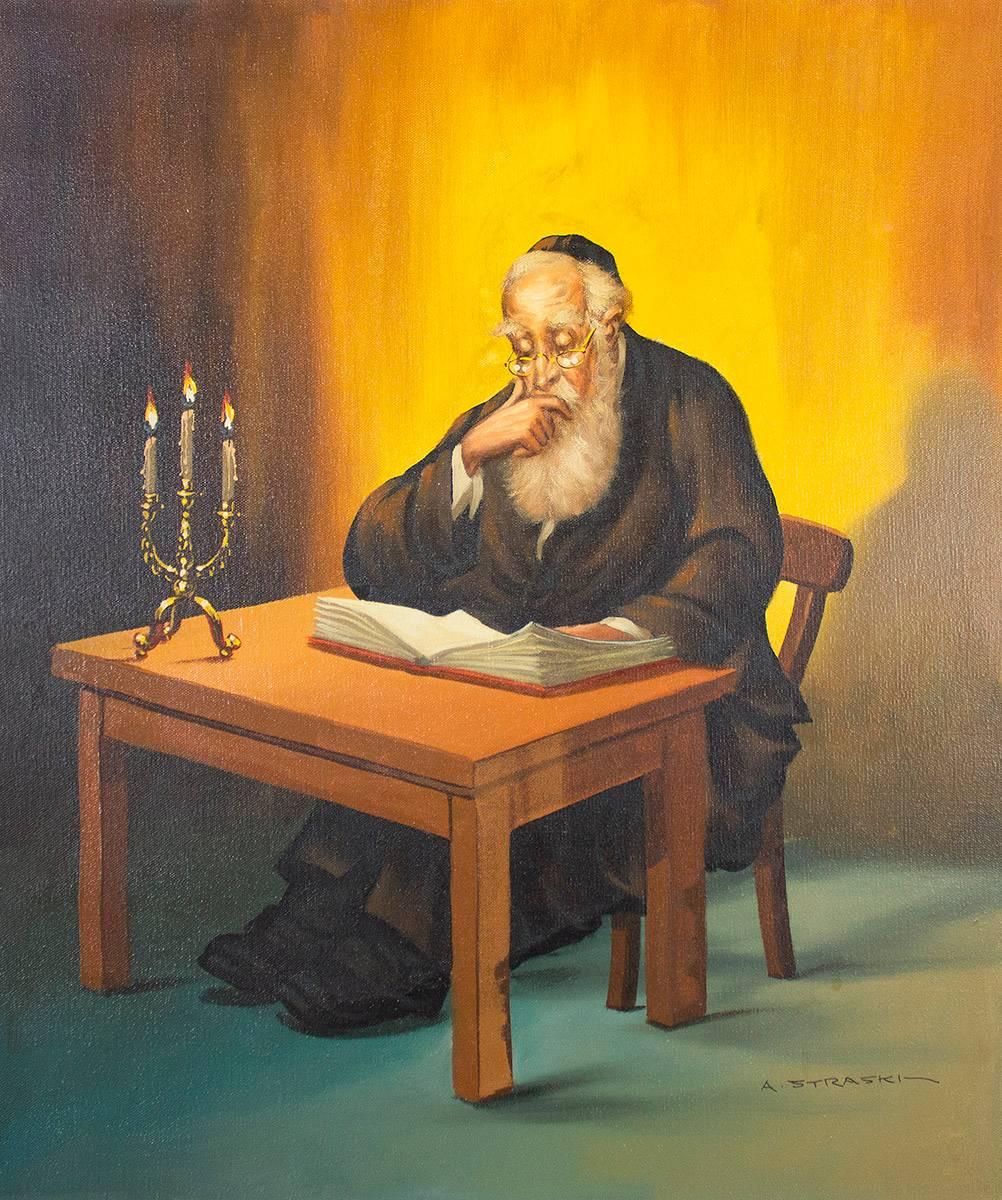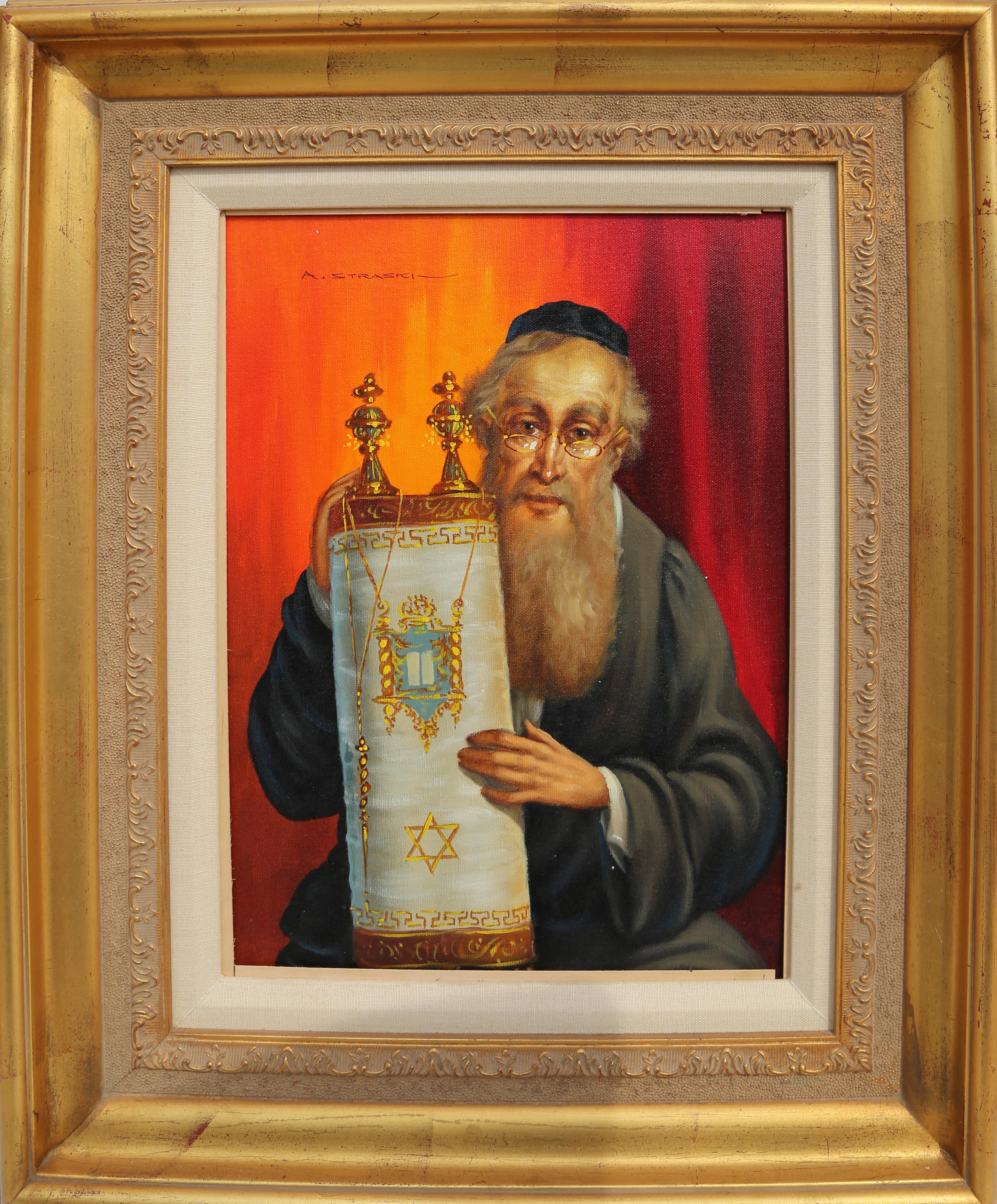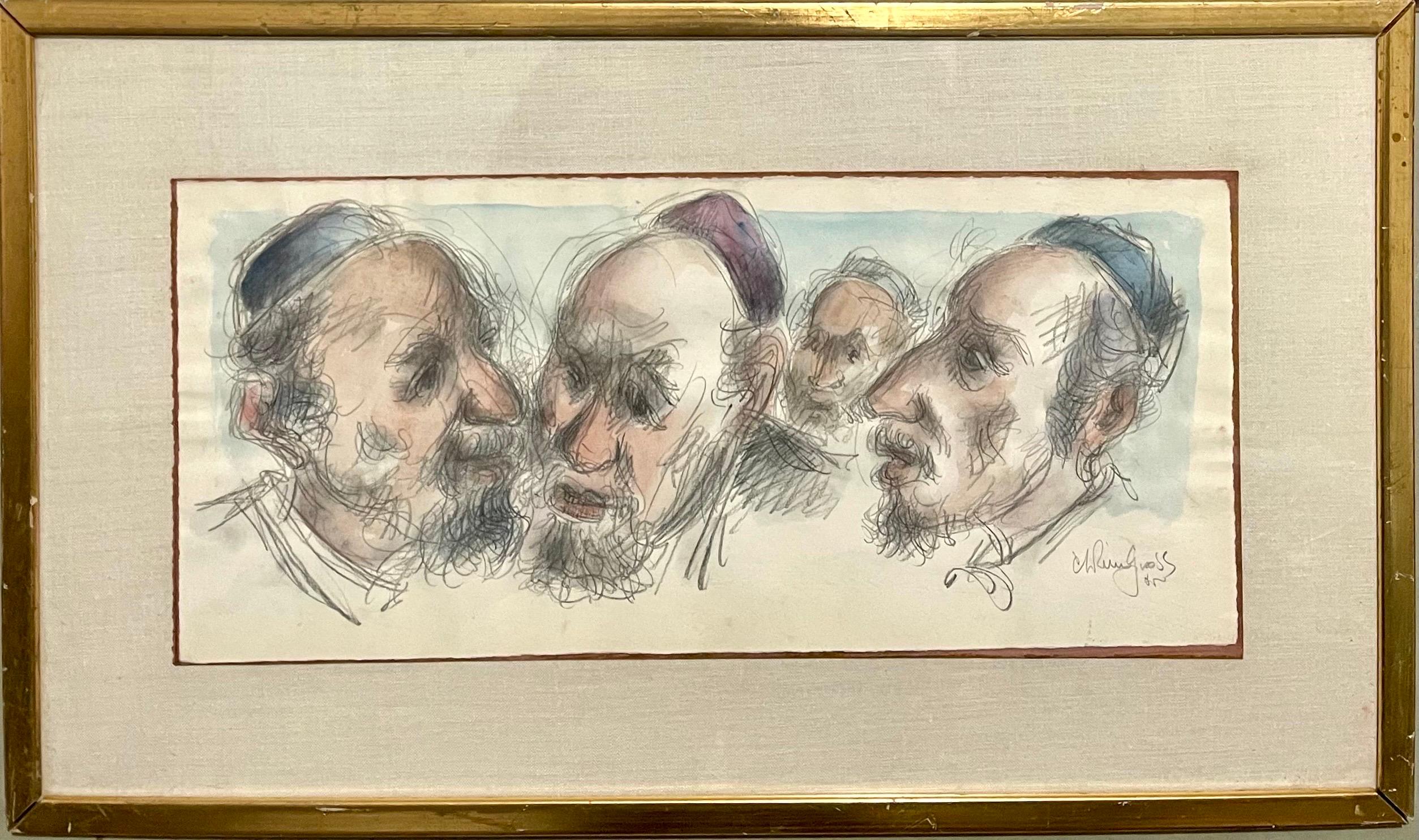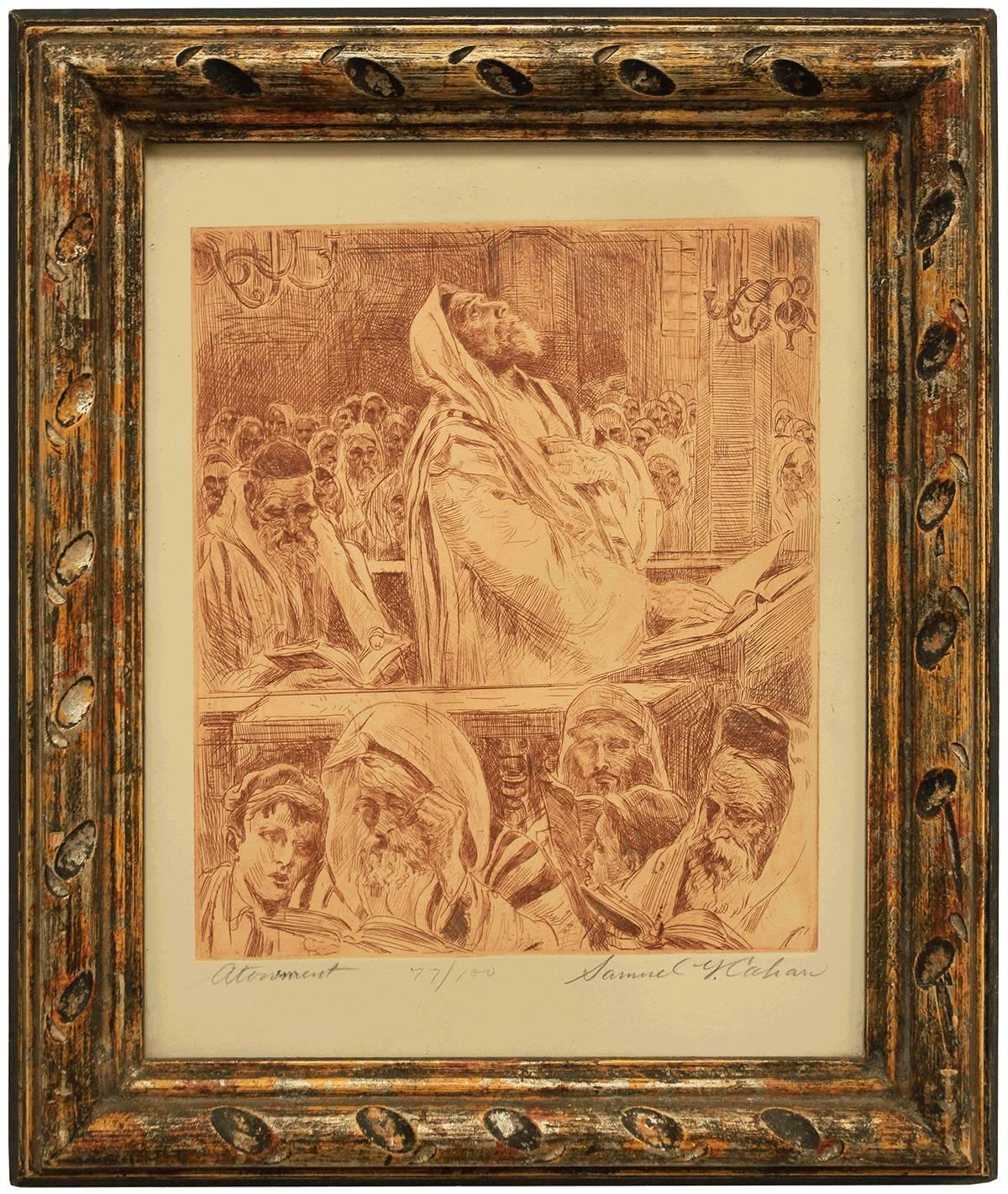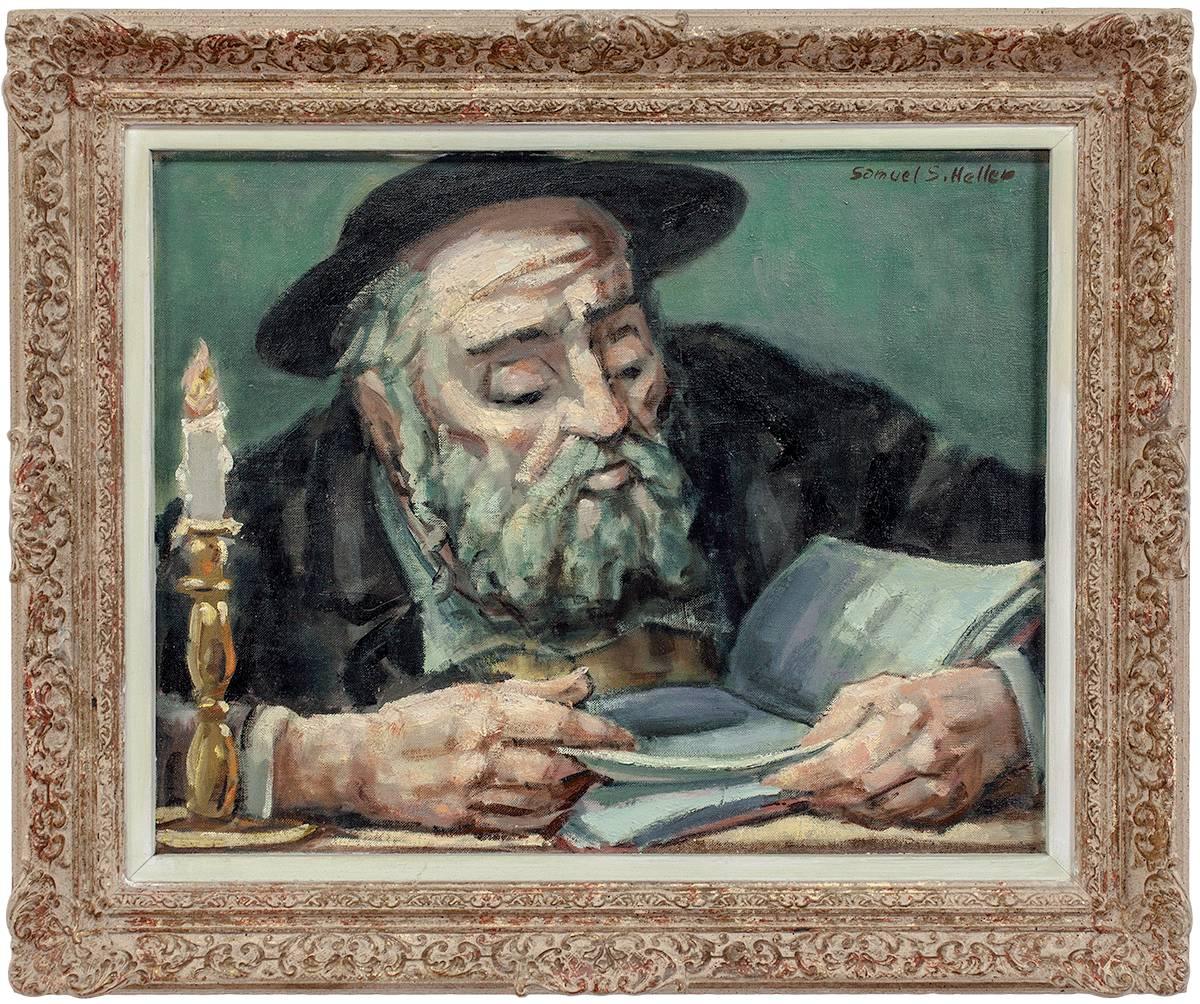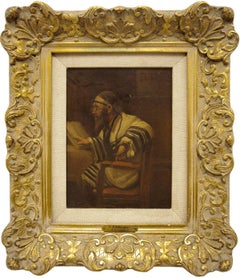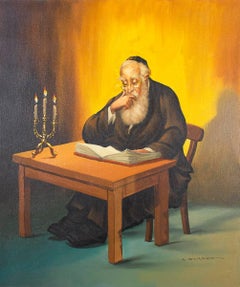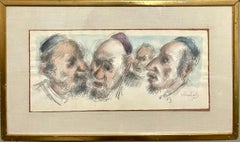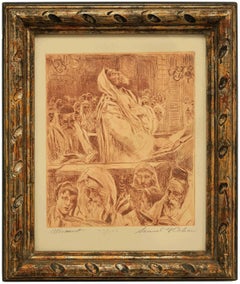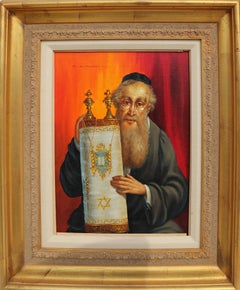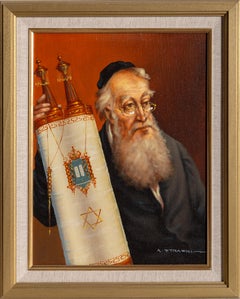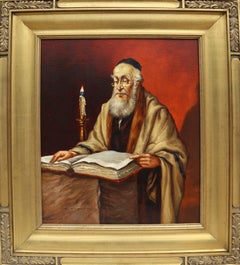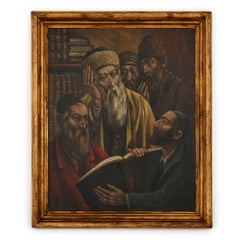Items Similar to Vintage Illustration Judaica Painting, The Rabbi's (Men at Prayers)
Want more images or videos?
Request additional images or videos from the seller
1 of 6
Samuel George CahanVintage Illustration Judaica Painting, The Rabbi's (Men at Prayers)
$2,600
£1,984.74
€2,281.59
CA$3,658.66
A$4,068.59
CHF 2,136.91
MX$49,742.56
NOK 26,627.95
SEK 25,102.96
DKK 17,028.01
About the Item
Genre: Judaica
Subject: Religious
Medium: Oil
Surface: Canvas
Country: United States
Dimensions: 24" x 18" x 3/4"
Dimensions w/Frame: 29" x 23"
Cahan uses vibrant oil paint to draw a portrait of four elderly Jewish men wearing prayer shawls also known as tallits. The man in the foreground is staring pensively into the distance while the other figures in the background read or pray. Each character shares the same scholarly air in their serious expressions and mannerisms. Cahan’s gestural use of color and brush strokes soften the painting’s protagonists, thereby shedding a more sensitive light on the painting.
The well-known twentieth century American illustrator, etcher, and painter Samuel George Cahan was born in Kovno, Russia, now part of Lithuania. His parents were both born in Russia during the early 1870’s. Two years after his birth, his family emigrated to America and eventually settled in New York City's Lower East Side. Cahan said that his interest for drawing started when he was only an infant. In a 1967 interview, the artist describes his primary school years as vastly disinteresting. While other students heeded their teachers or studied math, Cahan drew.
At 12-years-old, Cahan exhibited his early talent for drawing on Fulton Street’s sidewalk. Barefoot and armed with chalk, he crouched outside a restaurant and drew the sinking of Maine. At the time, it was recognizable ship that was smashed by the British. One of the men who passed by his vibrant rendering of the wreckage was the Chief Editor of the New York World newspaper, Nelson Hersh. Upon seeing the young boy’s skill, Hersh offered him a job in the newspaper’s art department. During his time at the newspaper, he worked on sketching court trials and learned from other prominent American artists working in the art department, such as George Luks.
After leaving the newspaper, he explored other artistic mediums that combined his love of color and line. From etchings on copper plates, he moved onto watercolor, and finally to oil. As an adult, he began to seriously study Fine art. Cahan first studied with the famous American artist Robert Henri. They would meet in the evenings along with other students including George Bellows and Stuart Davis. He continued his studies at the distinguished Art Students League of New York and eventually became a life member. Throughout his life, he exhibited his work with French & Company Gallery. In addition, he showed his work at the National Academy of Design where he was honored with several awards.
“An artist is not a camera,” was one of Cahan’s favorite mottos. He applied this belief to all his paintings. The artist was a great supporter of Judaism and would often take his inspiration from the Jewish community. Whether landscapes or portraits, many of his works blend his interest in culture, color, and narratives. Cahan uses gestural line and brush strokes to create emotion masterpieces that connect to broad audiences. Although Cahan died in 1974, he left a legacy of artworks that chronicle the Jewish community in New York City.
- Creator:Samuel George Cahan (January 11, 1886 - October 23, 1974, American)
- Dimensions:Height: 23 in (58.42 cm)Width: 29 in (73.66 cm)
- Medium:
- Movement & Style:
- Period:
- Condition:minor wear commensurate with age and use. (stretching can use some tightening).
- Gallery Location:Surfside, FL
- Reference Number:1stDibs: LU38211934422
About the Seller
4.9
Platinum Seller
Premium sellers with a 4.7+ rating and 24-hour response times
Established in 1995
1stDibs seller since 2014
1,801 sales on 1stDibs
Typical response time: <1 hour
- ShippingRetrieving quote...Shipping from: Surfside, FL
- Return Policy
Authenticity Guarantee
In the unlikely event there’s an issue with an item’s authenticity, contact us within 1 year for a full refund. DetailsMoney-Back Guarantee
If your item is not as described, is damaged in transit, or does not arrive, contact us within 7 days for a full refund. Details24-Hour Cancellation
You have a 24-hour grace period in which to reconsider your purchase, with no questions asked.Vetted Professional Sellers
Our world-class sellers must adhere to strict standards for service and quality, maintaining the integrity of our listings.Price-Match Guarantee
If you find that a seller listed the same item for a lower price elsewhere, we’ll match it.Trusted Global Delivery
Our best-in-class carrier network provides specialized shipping options worldwide, including custom delivery.More From This Seller
View AllRabbi In Prayer, Early 20th Century Oil Painting
By S. Sieberger
Located in Surfside, FL
Samuel Seiberger, (Seeberger) was a known artist and post-card designer who lived in Paris and was active circa 1900-1940. He was arrested for being a Jew when the Germans occupied Paris in the 1940s. He was brought into a concentration camp...
Category
Early 20th Century Modern Portrait Paintings
Materials
Oil
Rare Judaica Rabbi Painting
By Abraham Straski
Located in Surfside, FL
Genre: Judaica
Subject: Religious
Medium: Oil
Surface: Canvas
Country: United States
Dimensions: 24 x 20
Abraham Straski (1903 – 1987) was a Polish born painter who moved to the United States after surviving the Nazi concentrations camps...
Category
20th Century Impressionist Figurative Paintings
Materials
Oil
Chaim Gross Mid Century Mod Judaica Jewish Watercolor Painting Rabbis WPA Artist
By Chaim Gross
Located in Surfside, FL
Chaim Gross (American, 1904-1991)
Watercolor painting
Rabbinical Talmudic Discussion
Hand signed
17 x 29 framed, paper 10 x 22
Chaim Gross (March 17, 1904 – May 5, 1991) was an ...
Category
Mid-20th Century American Modern Figurative Drawings and Watercolors
Materials
Paper, Watercolor
A Fine Judaica Etching "Atonement" Yom Kippur in the Synagogue
By Samuel George Cahan
Located in Surfside, FL
In this copper plate etching, Cahan captures the religious ardor and penitent sentiment shared by the figures in the artwork. The piece is number seventy-six in a series of one-hundred etchings entitled Atonement. Cahan’s heavy use of line, as well as, his ability to convey emotion give the viewer a sensitive but harmonized rendering of Jewish prayer. Dimensions w/Frame: 17 1/2" x 15"
The well-known twentieth century American illustrator, etcher, and painter Samuel George Cahan was born in Kovno, Russia, now part of Lithuania. His parents were both born in Russia during the early 1870’s. Two years after his birth, his family emigrated to America and eventually settled in New York City's Lower East Side. Cahan said that his interest for drawing started when he was only an infant. In a 1967 interview, the artist describes his primary school years as vastly disinteresting. While other students heeded their teachers or studied math, Cahan drew.
At 12-years-old, Cahan exhibited his early talent for drawing on Fulton Street’s sidewalk. Barefoot and armed with chalk, he crouched outside a restaurant and drew the sinking of Maine. At the time, it was recognizable ship that was smashed by the British. One of the men who passed by his vibrant rendering of the wreckage was the Chief Editor of the New York World newspaper, Nelson Hersh. Upon seeing the young boy’s skill, Hersh offered him a job in the newspaper’s art...
Category
Mid-20th Century Figurative Prints
Materials
Etching
Rare Judaica Jewish Rabbi Oil Painting
By Samuel Heller
Located in Surfside, FL
Genre: Judaica
Subject: People
Medium: Oil
Surface: Board
Dimensions: 14 1/2" x 19"
Dimensions w/Frame: 20 1/4" x 24 1/4"
Category
Mid-20th Century Impressionist Figurative Paintings
Materials
Oil, Board
Rare Modernist Judaica Scholar Rabbi in Synagogue Oil Painting Signed Mora
Located in Surfside, FL
a mid century Judaica painting of a Rabbi wearing a Tallit prayer shawl. In the Modernist manner of Maurice Kish, Tully filmus or William Gropper. ...
Category
20th Century Folk Art Portrait Paintings
Materials
Oil
You May Also Like
Rabbi and Torah, Oil Painting by Abraham Straski
By Abraham Straski
Located in Long Island City, NY
Artist: Abraham Straski, Polish (1903 - 1987)
Title: Rabbi and Torah
Year: circa 1957
Medium: Oil on Canvas, signed l.r.
Image Size: 16 x 12 inches
Frame Size: 26 x 20 inches
Category
1950s Post-War Portrait Paintings
Materials
Canvas, Oil
Rabbi with Torah, Oil Painting by Abraham Straski 1950
By Abraham Straski
Located in Long Island City, NY
Rabbi with Torah
Abraham Straski, Polish (1903–1987)
Date: 1950
Oil on Canvas on Wood, signed and dated
Size: 16 x 12 in. (40.64 x 30.48 cm)
Frame Size: 19.5 x 15.5 inches
Category
1950s Post-War Portrait Paintings
Materials
Canvas, Oil, Wood
Rabbi Reading by Candlelight, Oil Painting by Abraham Straski, 1959
By Abraham Straski
Located in Long Island City, NY
Rabbi Reading by Candlelight (6-F)
Abraham Straski, Polish (1903–1987)
Date: 1959
Oil on Canvas, signed and dated
Size: 23 x 19 in. (58.42 x 48.26 cm)
Fr...
Category
1950s Post-War Portrait Paintings
Materials
Canvas, Wood, Oil
Polish Oil Painting of Jewish Men Studying by Arthur Bryks
By Arthur Bryks
Located in London, GB
Polish oil painting of Jewish men studying by Arthur Bryks
Polish, c. 1925-30
Frame: Height 108cm, width 89.5cm, depth 5cm
Canvas: Height 93cm, width 74.5cm
Painted by the Polish ar...
Category
Early 20th Century Portrait Paintings
Materials
Canvas, Oil
Judaica Portrait Oil Painting of a Rabbi Examining the Lulav Signed Rosendall
Located in Long Island City, NY
An oil painting on canvas representing a Judaica portrait of an old Rabbi, after the original oil painting, Examining the Lulav, . Signed by the artist, Rosendall, lower left. Framed...
Category
Antique 19th Century Unknown Paintings
Materials
Paint
“The Rabbi’s”
By Nahum Tschacbasov
Located in Southampton, NY
Original oil on canvas painting by the well known Russian/American artist, Nahum Tschacbasov.. The painting depicts a group of rabbi’s in conversation in an interior setting. Circa 1...
Category
1930s Ashcan School Figurative Paintings
Materials
Canvas, Oil
